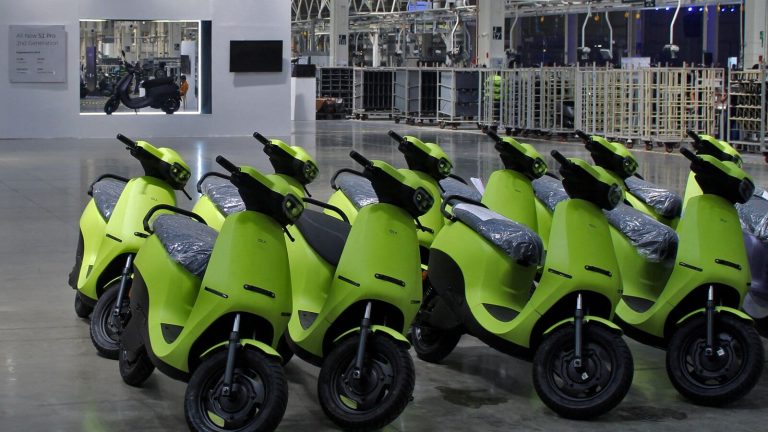New Delhi: Ola Electric Mobility Ltd did not disclose its monthly sales figures for the first time, following a month-long lull in registering new vehicles.
The Bengaluru-based electric scooter maker quoted data on the government’s Vahan portal to report 23,450 new vehicle registrations in March. The portal records registrations instead of company despatches.
A month ago, Ola had said that the Vahan portal would not record sales accurately due to issues in the company’s registration process.
“As shared earlier, the shift to in-house vehicle registrations in February led to temporary disruptions. While the transition continues, daily registration volumes and backlog clearance are steadily improving,” Ola Electric said in a filing on Tuesday.
In February, the Vahan portal showed Ola Electric’s new vehicle registrations at 8,653 units.
Bengaluru-based Ola Electric said on 19 February it was renegotiating contracts with third-party registration agencies Rosmerta Technologies Ltd and Shimnit India Pvt Ltd, leading to a slowdown. Rosmerta Group even took Ola to the National Company Law Tribunal over pending payments of about ₹26 crore. The case was later withdrawn by the agency after Ola Electric paid the full dues.
According to Ola, the disruption created a massive registration backlog of over 16,000 vehicles, which the company claimed would reflect on the Vahan portal over the next few weeks.
As a result of the backlog, the delivery time for vehicles increased to more than 20-45 days, Mint found during its enquiries at several company-owned stores. However, Ola claims the average delivery time has been reduced from 12 days to 3-4 days.
Ola Electric has informed stock exchanges on Tuesday that it has “nearly cleared” this backlog and the company expects to complete the remaining February–March registrations in April 2025. “To support this, we’re scaling up our registration operations and actively coordinating with all external stakeholders.”
Earlier, the agencies handled the registration process, entering customer details on the government portal and printing the generated numbers on number plates. When its contract with the agencies ended, Ola hired 200 people to aid in the registration process, according to a company executive aware of the development.
However, the March numbers suggest the backlog has not been fully cleared. It’s also not clear how many vehicles were actually sold in March, besides the number of scooters it sold but couldn’t register during the month.
Going by the backlog of 16,000, the company registered only around 6,000 new vehicles in March, dragging the maker of the S1 series of electric scooters to third place by market share.
Emailed queries to Ola Electric didn’t elicit a response.
Bajaj Auto, TVS race ahead
Legacy automakers such as Bajaj Auto Ltd and TVS Motors Ltd recorded growth in new registrations month-on-month in March, and overtook Ola Electric, which had claimed to have the highest market share in February with over 25,000 units sold.
In March, Bajaj Auto claimed the top spot in the electric two-wheeler market with 34,863 new registrations, a nearly 62% increase over the previous month’s 21,537. Similarly, Hosur-based TVS Motors Ltd recorded 30,454 new registrations, a month-on-month growth of 61%.
India’s overall electric vehicle market closed FY25 on a positive note, with new vehicle registrations rising 16.86% to 1.96 million units compared to the previous year’s 1.68 million, as per Vahan data.
Dent in Ola’s FY25 revenue
Ola Electric’s registration woes in February and March are likely to dent the company’s revenue for FY25.
Since the company has not disclosed its monthly sales or its new vehicle registrations excluding the previous month’s backlog, it is not possible to ascertain the revenue or incentives that the company will have to forego in FY25.
The company’s draft red herring prospectus stated that it recognizes revenue “upon transfer of control of promised products or services to customers”.
It remains unclear whether the company will book the revenue from the sales of unregistered vehicles as their ownership hasn’t been transferred to the customers yet.
Mint also reported on 19 March that Ola Electric could potentially lose out on government incentives under the PM E-drive scheme if it does not clear its vehicle registration backlog. Under the scheme, manufacturers sell their electric vehicles to consumers at a subsidised price, and the government reimburses manufacturers for the difference.
Also read | Ola Electric’s scooter deliveries hit as it seeks to cut registration firm costs
But the catch with this scheme is its tapering subsidies. The ₹10,900-crore is spread over FY25 and FY26, with incentives being halved from ₹10,000 per electric two-wheeler to ₹5,000 per unit in FY26.
The vehicles that Ola Electric sold in FY25 are eligible for a ₹10,000 subsidy. But since they will be registered in April, Ola Electric will only be able to apply for these subsidies in FY26 at ₹5,000 per vehicle.
Ola Electric’s share price has declined by nearly 13% since it started facing registration issues compared to a 9% fall in the BSE auto index.
The number of registrations still remains far off the 50,000 target Ola Electric founder Bhavish Aggarwal had set to achieve profitability. The company reported a ₹564 crore loss in the October to December quarter as against ₹376 crore in the year-ago period.
“The company will have to resolve its technical issues as well as increase volume at a sustainable pace because these problems will keep hurting investor sentiment,” said Avinash Gorakshakar, head-research at Profitmart, a Mumbai-based brokerage. “It is not clear when the company will turn profitable, and in a loss-making enterprise, investors will remain cautious. It is a wait-and-watch situation to see by when are they able to resolve all the issues.”
Catch all the Business News , Corporate news , Breaking News Events and Latest News Updates on Live Mint. Download The Mint News App to get Daily Market Updates.
MoreLess


